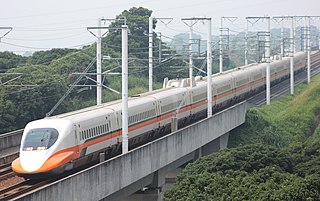
Taiwan High Speed Rail (THSR) is the high-speed railway of Taiwan consisting of one line that runs approximately 350 km (217 mi) along the west coast, from the capital Taipei to the southern city of Kaohsiung. With construction and operations managed by a private company, Taiwan High Speed Rail Corporation, which also operates the line, the total cost of the project was NT$513.3 billion in 1998. At the time it was built, this was one of the world's largest privately funded rail construction schemes. The system's technology is based primarily on Japan's Shinkansen.

The THSR 700T is the high-speed electric multiple unit trainset derived from the Japanese Shinkansen family for Taiwan High Speed Rail (THSR), Taiwan's high-speed rail line. The THSR 700T is based primarily on the 700 Series Shinkansen that currently operates on the San'yō Shinkansen line and formerly on the Tokaido Shinkansen line in Japan, with the "T" referring to Taiwan. The trains were manufactured in Japan by Kawasaki Heavy Industries, Nippon Sharyo, and Hitachi, Ltd., marking the first time Japanese Shinkansen trains have been exported overseas. 30 trains were delivered to THSR operator Taiwan High Speed Rail Corporation (THSRC), and are in regular service with a top speed of 300 kilometres per hour (186 mph) since the line's opening on January 5, 2007.

Taipei Mass Rapid Transit (MRT), branded as Metro Taipei, is a rapid transit system serving the areas of Taipei and New Taipei in Taiwan, operated by the government-owned Taipei Rapid Transit Corporation. In 2023, operation of the Circular line was transferred to New Taipei Metro.

Kaohsiung Metro is a rapid transit and light rail system covering the metropolitan area of Kaohsiung, Taiwan. Its rapid transit network is known as Kaohsiung Mass Rapid Transit or Kaohsiung MRT. Construction of the MRT started in October 2001. The MRT opened in 2008 and the Circular light rail in 2015. Kaohsiung Metro is operated by the Kaohsiung Rapid Transit Corporation under a BOT contract the company signed with the Kaohsiung City Government.
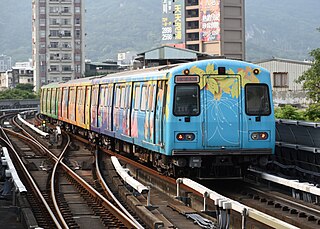
The Taipei Metro Xinbeitou branch line is an elevated, high-capacity branch line of the Tamsui–Xinyi line. It first opened for service on 28 March 1997. The line is 1.2 km (0.75 mi) long and consists of two stations.

Taiwan Taoyuan International Airport MRT, commonly known as the Airport MRT, is a rapid transit line of Taoyuan Metro that connects the municipalities of Taipei, New Taipei, and Taoyuan with Taoyuan International Airport. The 51.03 km (31.71 mi) line, from Taipei Main Station to Huanbei, has 21 stations and began commercial service on 2 March 2017.
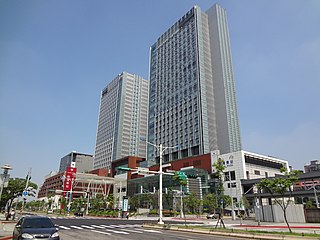
Nangang is a railway and metro station in Taipei, Taiwan served by Taiwan High Speed Rail, Taiwan Railways Administration and Taipei Metro. The station is served by the fastest HSR express services of the 1 series.
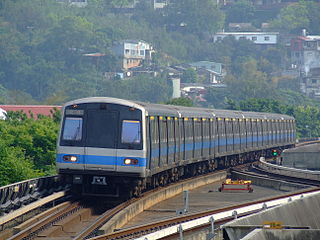
The Taipei Metro C301 is the first generation of heavy-capacity electric multiple units on the Taipei Metro in Taipei, Taiwan. Built by Kawasaki Heavy Industries and Union Rail Car Partnership between 1992 and 1994, it was introduced on the Tamsui line in 1997.

Kaohsiung Main Station is a railway and metro station in Sanmin District, Kaohsiung, Taiwan served by the Taiwan Railways and Kaohsiung Rapid Transit. It is one of four special class stations, the highest class with the most services. It is currently undergoing reconstruction, scheduled to be complete in 2024.

The Taoyuan Metro is a rapid transit system serving Taoyuan City, as well as parts of New Taipei City and Taipei City, in Taiwan. The most recently proposed network includes 11 lines and extensions, of which 2 are now under construction. The Taoyuan Airport MRT is the only line currently in operation. The system opened with the opening of the first line in the system, Taoyuan Airport MRT, for trial passenger service on 2 February 2017 and revenue passenger service on 2 March 2017.

World Games is a station on the Red line of Kaohsiung MRT in Nanzih District, Kaohsiung, Taiwan. The station is named after the World Games 2009.

Kaohsiung International Airport is a station on the Red line of Kaohsiung MRT in Siaogang District, Kaohsiung, Taiwan.

The Taipei Metro C371 is the fourth generation of heavy-capacity rolling stock used on the Taipei Metro in Taipei, Taiwan. Built by Kawasaki Heavy Industries and Taiwan Rolling Stock Company between 2005 and 2009, it was introduced on the Xindian and Zhonghe Lines in 2006 and on the Xinbeitou and Xiaobitan branch lines in 2007.

The Taipei Metro C321 is the second generation of heavy-capacity rolling stock used on the Taipei Metro in Taipei, Taiwan. Built by Siemens Mobility in Germany, it was introduced on the Bannan line in 1999.

The Taipei Metro C341 is the third generation of electric multiple units on the Taipei Metro in Taipei, Taiwan. Built by Siemens Mobility and SGP Verkehrstechnik in Austria, it was introduced on the Bannan line in 2004.

The Taipei Metro C381 is the fifth and the latest generation of heavy-capacity electric multiple units on the Taipei Metro in Taipei, Taiwan. They are designed to increase the capacity of the expanded network with the opening of the Xinyi and Songshan lines.

The Yellow Line, also known as the Kaohsiung Metropolitan line, is a planned medium capacity rapid transit line on the Kaohsiung Metro. The line has been approved by the Executive Yuan in March 2022, and construction is expected to start in late 2022.
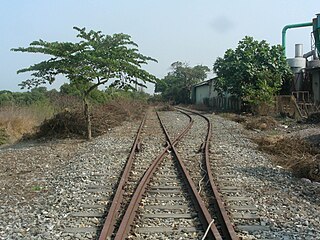
The Donggang line was a railway line of the Taiwan Railways Administration that ceased operations in July 2002. The line was a branch line of the Pingtung Line, diverging at Zhen'an Station to the coastal town of Donggang. The route ran parallel to the current-day Provincial Highway 17.
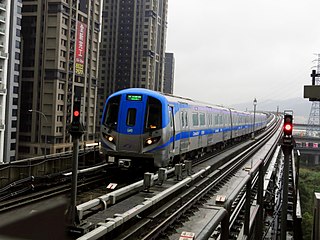
The Taoyuan Metro 1000 series, also referred to as Commuter Trains, are the electric multiple unit train types that are used for the all-stop Commuter services on the Taoyuan Airport MRT.

The Taoyuan Metro 2000 series, also referred to as Express Trains, are the electric multiple unit train types that are used for the limited-stop Express services on the Taoyuan Airport MRT.






















